Exploring the depths of the celestial world, we find ourselves captivated by the enigmatic realm of Ophiuchus, a constellation nestled between Scorpio and Sagittarius. But this is no ordinary constellation; it holds the key to a hidden treasure trove of mythical creatures that have woven themselves into the tapestry of different cultures throughout history. From the mystical beasts of Chinese folklore to the legendary beings of Greek mythology, the influence of Ophiuchus knows no bounds. So, join us on a journey as we unravel the captivating tales of the Azure Dragon and the Vermilion Bird from Chinese culture, the Asclepius Serpent and the Centaur from Greek mythology, the Uraeus Snake and the Griffin from Egyptian mythology, and finally, the Thunderbird and the Horned Serpent from Native American folklore. Let’s dive into the enthralling world of mythical creatures associated with Ophiuchus in different cultures.
Contents
- Chinese Culture
- Greek Mythology
- Egyptian Mythology
- Native American Folklore
- Conclusion
-
Frequently Asked Questions
- 1. What is Ophiuchus in astrology?
- 2. How does Ophiuchus impact horoscopes?
- 3. What is the significance of the Azure Dragon in Chinese culture?
- 4. Who is Asclepius in Greek mythology?
- 5. What is the symbolism of the Uraeus Snake in Ancient Egypt?
- 6. What is the Thunderbird in Native American folklore?
- 7. Is there a connection between Ophiuchus and Native American mythology?
- 8. What role does the Centaur play in Greek mythology?
- 9. How does Chinese astrology incorporate Ophiuchus?
- 10. Can Ophiuchus influence romantic compatibility?
- References
-
Frequently Asked Questions
- 1. What is Ophiuchus and its significance in astrology?
- 2. Is Ophiuchus recognized as a zodiac sign?
- 3. How does Ophiuchus relate to mythical creatures?
- 4. What is the significance of the Azure Dragon in Chinese culture?
- 5. How does the Vermilion Bird relate to Ophiuchus in Chinese culture?
- 6. Who is the Asclepius Serpent in Greek mythology?
- 7. What role does the Centaur play in Greek mythology?
- 8. What is the Uraeus Snake in Egyptian mythology?
- 9. How does the Griffin relate to Ophiuchus in Egyptian mythology?
- 10. What is the significance of the Thunderbird in Native American folklore?
- References
- Read More
Chinese Culture
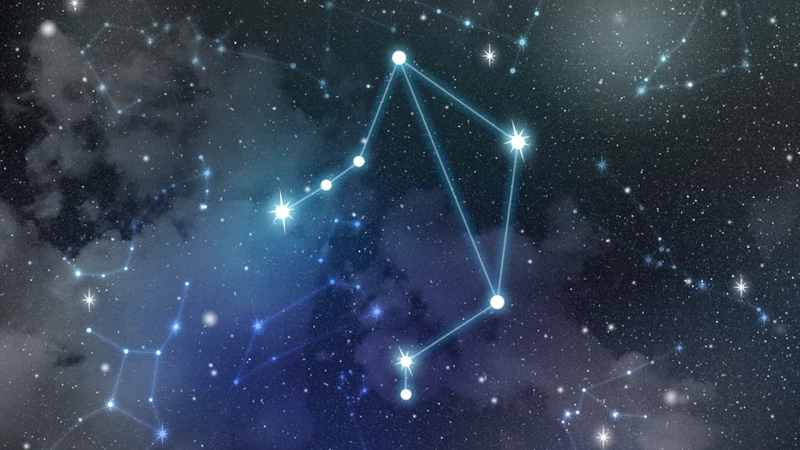
Immersed in the rich tapestry of Chinese culture, Ophiuchus unfurls its mystical allure through two captivating mythical creatures – the Azure Dragon and the Vermilion Bird. The Azure Dragon, also known as Qinglong, embodies the strength and power of the eastern cardinal direction. With its verdant scales and formidable presence, this legendary creature symbolizes good fortune, protection, and prosperity. On the other hand, the Vermilion Bird, or Zhuque, represents the south cardinal direction and radiates vibrant hues of crimson and gold. Known for its grace and elegance, this magnificent avian creature embodies passion, love, and change. These revered creatures, intertwined with the celestial realm of Ophiuchus, continue to captivate our imagination and remind us of the vast depths of Chinese mythology. [Link: /influence-of-zodiac-signs-relationships-love/]
The Azure Dragon
The Azure Dragon, known as Qinglong in Chinese mythology, is a mythical creature deeply entrenched in the cultural fabric of China. Revered as one of the Four Symbols of the Chinese constellations, this majestic creature represents the east cardinal direction and holds significant symbolism. With its emerald scales that shimmer under the celestial light, the Azure Dragon embodies the qualities of strength, power, and good fortune.
According to ancient Chinese beliefs, the Azure Dragon is associated with the element of wood and the season of spring. It is said to bring abundance, fertility, and prosperity to those under its celestial influence. Often depicted in artwork and architectural structures, this divine creature holds a prominent place in Chinese folklore.
The Azure Dragon holds a close connection to the mythological figure of the Yellow Emperor, Huangdi, who is considered the legendary progenitor of Chinese civilization. It is believed that Huangdi rode on the back of the Azure Dragon as a divine mount, symbolizing his authority and wisdom.
In addition to its celestial significance, the Azure Dragon is also recognized for its benevolent nature and protective qualities. It is seen as a guardian against evil and brings blessings and good fortune to those who revere it. Its presence is often sought for protection in homes, temples, and other sacred spaces.
The influence of the Azure Dragon extends beyond mythology and folklore, permeating various aspects of Chinese culture. It is a symbol frequently associated with the Chinese zodiac, representing the birth year of those born under its sign. Individuals born in the Year of the Dragon are said to possess qualities of strength, vitality, and success.
Throughout the ages, the Azure Dragon has inspired countless works of art, poetry, and literature, further solidifying its place in the hearts and minds of the Chinese people. Its enduring presence in Chinese culture serves as a testament to the deep-rooted connection between mythology, symbolism, and the collective consciousness of a proud and ancient civilization. [Link: /ophiuchus-film-television-portrayals/]
The Vermilion Bird
The Vermilion Bird, also known as Zhuque in Chinese mythology, is a captivating creature associated with the southern cardinal direction and the celestial realm of Ophiuchus. This legendary bird is believed to possess extraordinary beauty and grace, with its plumage radiating vibrant hues of vermilion, gold, and crimson. While being known for its aesthetic magnificence, the Vermilion Bird is also revered for its symbolism and significance. In Chinese culture, this mythical creature represents passion, love, and change. It serves as a powerful symbol of rebirth, renewal, and transformation. The Vermilion Bird is often depicted in art, literature, and various cultural practices, highlighting its enduring influence on Chinese society. Its representation is frequently seen in ancient architecture, traditional garments, and even contemporary designs. This mythical bird’s connection to Ophiuchus adds depth to its lore, intertwining celestial and earthly realms in Chinese mythology. The Vermilion Bird’s majestic presence and profound symbolism continue to captivate and inspire, embodying the essence of transformation and the eternal cycle of life. [Link: /12-labors-hercules-roman-mythology/]
Greek Mythology
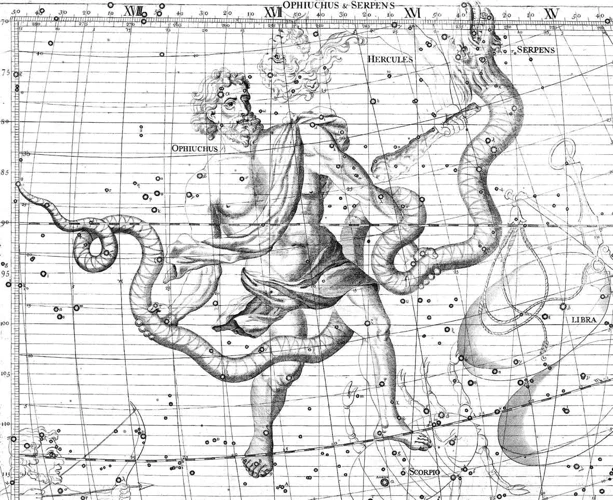
In the realm of Greek mythology, Ophiuchus reigns supreme, giving rise to two iconic mythical creatures – the Asclepius Serpent and the Centaur. The Asclepius Serpent, also known as the Rod of Asclepius, intertwines its slithering form around a staff, symbolizing healing and medicine. This revered creature represents the wisdom and knowledge bestowed upon humankind and is closely associated with the god of healing, Asclepius. On the other hand, the Centaur stands as a legendary creature with the upper body of a human and the lower body of a horse. Often depicted as wise and noble beings, centaurs embody the delicate balance between civilization and untamed nature. They symbolize the duality of both human and animal instincts, reminding us of our primal connection to the natural world. These enchanting creatures add depth and wonder to the ever-captivating tales of Greek mythology.
The Asclepius Serpent
The Asclepius Serpent, a prominent figure in Greek mythology, is closely associated with Ophiuchus. Asclepius, the Greek god of healing and medicine, is often depicted with a staff entwined by a serpent – the iconic symbol of medicine known as the Rod of Asclepius. This sacred serpent, believed to possess healing powers, represents rejuvenation and transformation. Mythology suggests that Asclepius was the son of Apollo and was taught the art of medicine by the wise centaur Chiron. Legend has it that Asclepius’ ability to resurrect the dead alarmed the gods, leading to his demise by Zeus’ lightning bolt. However, Zeus honored him by placing Asclepius in the heavens as the constellation Ophiuchus, forever guiding and inspiring healers. The Asclepius Serpent serves as a timeless emblem of healing and the intricate connection between celestial forces and earthly well-being. Its enduring influence can be observed in the medical field, where the Rod of Asclepius remains a universally recognized symbol of healthcare.
The Centaur
In Greek mythology, is a creature that holds a prominent place in the tales of Ophiuchus. With the head, arms, and torso of a human and the body of a horse, the Centaur is a symbol of duality, representing both the civilized and untamed aspects of our nature. These mythical beings are known for their exceptional strength and expertise in archery. Often depicted as wise teachers, Centaurs possess a vast knowledge of medicine and the arts, making them highly revered figures. The most renowned Centaur in Greek mythology is Chiron, known for his wisdom and mentorship of many revered heroes, including Achilles and Hercules. However, not all Centaurs share this noble reputation. There are tales of unruly Centaurs who were wild and violent, often depicted as indulging in excessive drinking and revelry. The Centaur’s composite form has fascinated storytellers, painters, and sculptors throughout history, serving as a reminder of the multifaceted nature of humanity.
Egyptian Mythology
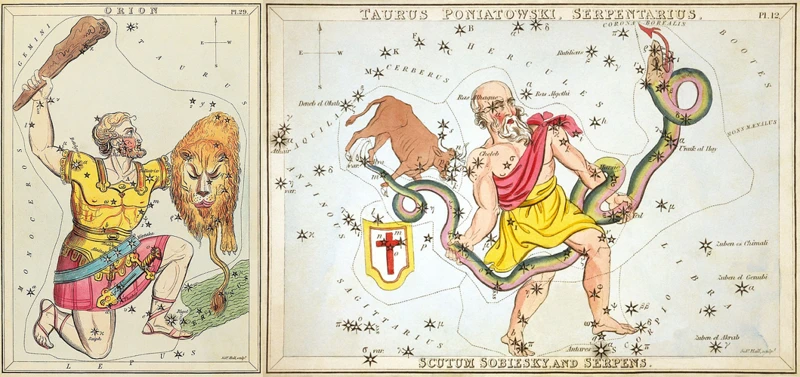
Journeying into the realm of Egyptian mythology, the distinguished figure of Ophiuchus unveils a captivating duo of mythical creatures – the Uraeus Snake and the Griffin. The Uraeus Snake, a powerful symbol of protection and sovereignty, gracefully coils around the Pharaoh’s crown, serving as a guardian against malevolent forces. Its fierce gaze and venomous bite strike fear into the hearts of adversaries. Meanwhile, the Griffin, a wondrous creature with the body of a lion and the head and wings of an eagle, symbolizes strength, wisdom, and vigilance. Revered as the king of all creatures, the Griffin embodies the duality of the physical and spiritual realms, including the domains of Ophiuchus. These exceptional mythical beings of Egyptian lore continue to mesmerize with their majestic presence and potent symbolism.
The Uraeus Snake
The Uraeus Snake, originating from ancient Egyptian mythology, holds a significant place in the pantheon of Ophiuchus-associated mythical creatures. This revered serpent is symbolically represented as a cobra with an upright stance, poised and ready to strike. The Uraeus Snake is closely linked with royalty and is often depicted on the headdresses and crowns of pharaohs, serving as a symbol of their divine authority and protection. The Uraeus Snake is believed to possess the power to ward off evil and safeguard the wearer from harm. Its association with Ophiuchus adds another layer of mystique, as Ophiuchus represents healing and medicine. The snake’s presence within the constellation further emphasizes its connection to the restoration of balance and harmony. In Egyptian mythology, the Uraeus Snake reminds us of the delicate interplay between life, death, and transformation, and its association with Ophiuchus encapsulates the healing aspect of this divine creature.
The Griffin
The Griffin, a mythical creature from Egyptian mythology associated with Ophiuchus, is a fascinating hybrid creature with the body of a lion and the head and wings of an eagle. This majestic beast is believed to possess great strength, intelligence, and powers of protection. In Egyptian culture, the Griffin was revered as a guardian and symbol of divine power. It was often depicted as a sentinel, watching over sacred spaces and protecting them from any harm or evil. Renowned for its keen vision and swift flight, it was believed that the Griffin had the ability to soar high above the mortal realm and communicate with the celestial beings. Often associated with the sun and representing strength and sovereignty, the Griffin holds a significant place in ancient Egyptian folklore and continues to captivate our imagination with its regal presence.
Native American Folklore
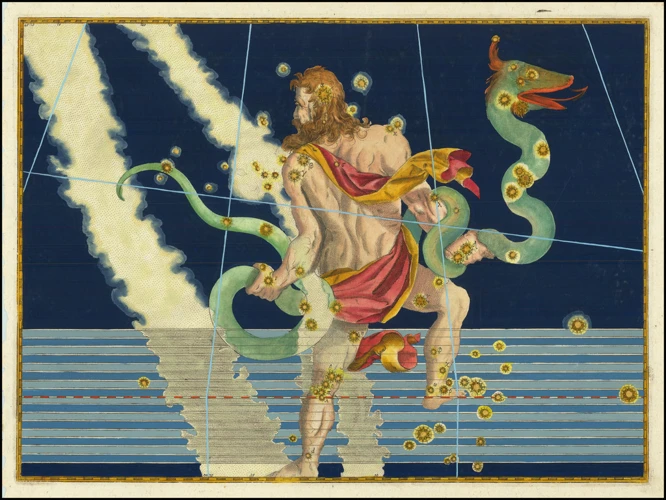
Deep within the realms of Native American folklore lies a captivating connection to Ophiuchus, where two legendary mythical creatures reign supreme – the Thunderbird and the Horned Serpent. The Thunderbird, known for its majestic wingspan and mighty thunderous roar, represents power and strength. This legendary avian creature possesses the ability to control the elements and is revered as a symbol of protection and divine intervention. In contrast, the Horned Serpent, often depicted with a serpentine body adorned with magnificent horns, is a mythical water creature associated with wisdom and transformation. It is believed to possess healing and spiritual powers, and its presence is synonymous with waterways, lakes, and underground springs. These awe-inspiring beings woven into Native American folklore exemplify the harmony between nature, spirituality, and the celestial realm of Ophiuchus, leaving us in awe of their legendary presence.
The Thunderbird
The Thunderbird, an awe-inspiring creature deeply rooted in Native American folklore, commands the skies and holds great significance in many indigenous cultures. This majestic avian creature is said to possess wings that generate thunderous claps and lightning bolts with each powerful beat. Representing strength, power, and protection, the Thunderbird is often associated with storms and considered a symbol of transformation and renewal. It is believed that the Thunderbird has the ability to bring rain and bring balance to the natural world. With its expansive wingspan and piercing gaze, this mythical creature instills both awe and reverence among those who encounter it. Legends of the Thunderbird echo throughout Native American folklore, tales of its mighty presence and its role as a guardian of the heavens continue to inspire and captivate generations. The Thunderbird’s enduring legacy serves as a reminder of the deep spiritual connection between humans and nature, and its significance in Native American culture is truly extraordinary.
The Horned Serpent
In Native American folklore, the Horned Serpent emerges from the depths of rivers and lakes, captivating the imaginations of those who encounter it. With its serpentine body covered in iridescent scales, the Horned Serpent is known for its majestic and awe-inspiring presence. This mythical creature is often depicted with deer-like antlers crowning its head, symbolizing its connection to the earthly and spiritual realms. According to legends, the Horned Serpent possesses great wisdom and power and is considered a symbol of transformation and healing. It is believed that those who encounter the Horned Serpent may be blessed with its guidance and protection. The serpent’s association with water reflects its association with life, fertility, and renewal. The Horned Serpent holds a significant place in Native American folklore, representing the delicate balance between the natural world and the realm of the supernatural.
Conclusion
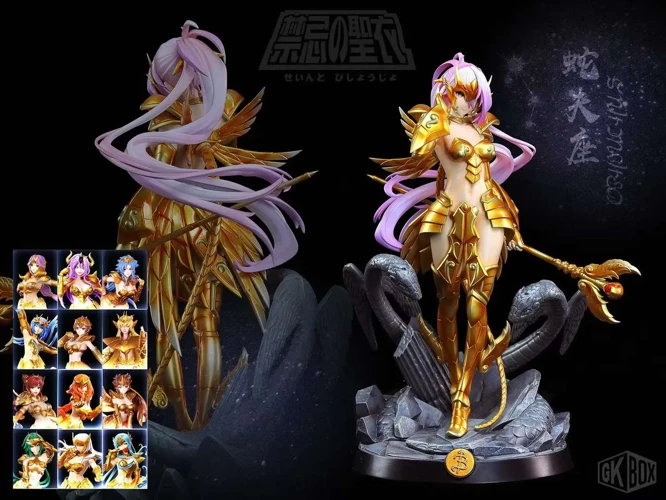
In conclusion, the world of Ophiuchus and its mythical creatures is a testament to the fascinating diversity of cultures and their interpretations of astrology and celestial beings. From the majestic Azure Dragon and Vermilion Bird in Chinese culture to the mysterious Asclepius Serpent and Centaur in Greek mythology, and from the enchanting Uraeus Snake and Griffin in Egyptian mythology to the awe-inspiring Thunderbird and Horned Serpent in Native American folklore, each culture has woven its own unique stories and symbolism around Ophiuchus.
These mythical creatures associated with Ophiuchus serve as a reminder of the human fascination with the cosmos and our eternal search for meaning in the celestial realm. Whether it be through tales of protection, wisdom, healing, or strength, these mythical creatures have left an indelible mark on the cultural fabric of civilizations across the globe.
As we delve into the realms of mythology and folklore, we gain a deeper appreciation for the human imagination and our innate desire to create narratives that transcend time and boundaries. The influence of Ophiuchus and its associated mythical creatures continues to intrigue and inspire us, serving as a testament to the enduring power of storytelling and the wonders of the universe.
So, let us celebrate the vibrant tapestry of cultures and their mythical interpretations of Ophiuchus, for they remind us of the boundless beauty and diversity of human creativity. As we gaze at the stars and contemplate the mysteries of the cosmos, we are reminded of the eternal connection between humanity and the celestial wonders that lie beyond our reach.
Frequently Asked Questions

1. What is Ophiuchus in astrology?
In astrology, Ophiuchus is the 13th zodiac sign, situated between Scorpio and Sagittarius. It represents the serpent-bearer and is associated with healing, wisdom, and mystical energy.
2. How does Ophiuchus impact horoscopes?
Ophiuchus’s inclusion in the zodiac has led to debates about its influence on horoscopes. Some astrologers believe that those born under Ophiuchus may exhibit traits related to healing, intuition, and transformation.
3. What is the significance of the Azure Dragon in Chinese culture?
The Azure Dragon, or Qinglong, holds great significance in Chinese culture. It is considered one of the four celestial guardians and represents power, protection, wisdom, and good fortune.
4. Who is Asclepius in Greek mythology?
Asclepius is a prominent figure in Greek mythology, associated with healing and medicine. He is often depicted with a serpent-entwined staff, known as the Rod of Asclepius, which has become a symbol of medicine.
5. What is the symbolism of the Uraeus Snake in Ancient Egypt?
The Uraeus Snake represented the divine authority of Egyptian pharaohs. It was a sacred symbol associated with protection, royal power, and the fiery energy of the sun god, Ra.
6. What is the Thunderbird in Native American folklore?
The Thunderbird is a legendary creature in Native American folklore, often depicted as a large bird with thunderous wings. It is associated with storms, rain, and supernatural powers, revered as a symbol of strength and transformation.
7. Is there a connection between Ophiuchus and Native American mythology?
While Ophiuchus originates from Greek mythology, there isn’t a direct connection between Ophiuchus and Native American mythology. However, both mythologies carry the theme of celestial beings and their profound influence on human existence.
8. What role does the Centaur play in Greek mythology?
The Centaur is a mythical creature with the upper body of a human and the lower body of a horse. In Greek mythology, Centaurs were known for their wild nature and often depicted as wise and knowledgeable beings, skilled in music and warfare.
9. How does Chinese astrology incorporate Ophiuchus?
In traditional Chinese astrology, Ophiuchus is not considered a zodiac sign. Chinese astrology focuses on a twelve-year cycle represented by animal signs, with each year associated with specific characteristics and traits.
10. Can Ophiuchus influence romantic compatibility?
While Ophiuchus isn’t commonly considered in traditional astrology, some individuals may explore its influence on romantic compatibility. However, it is important to remember that astrology is multifaceted, and compatibility depends on various factors beyond the zodiac sign.
References
- Ophiuchus Location, Mythology & Features
- Ophiuchus | Astrology, Zodiac, Mythology
- Ophiuchus Sign Mythology, History, and Meaning
Frequently Asked Questions

1. What is Ophiuchus and its significance in astrology?
Ophiuchus is a constellation that lies between Scorpio and Sagittarius. In astrology, it represents the Serpent Bearer and is associated with healing, knowledge, and transformation.
2. Is Ophiuchus recognized as a zodiac sign?
While Ophiuchus is not officially recognized as a zodiac sign in the traditional Western astrology system, it has gained popularity in recent years as a 13th sign due to the precession of the Earth’s axis.
3. How does Ophiuchus relate to mythical creatures?
Ophiuchus is often associated with mythical creatures due to its mythological connections and symbolism. These creatures are said to have a connection with healing, wisdom, and the mysteries of life.
4. What is the significance of the Azure Dragon in Chinese culture?
The Azure Dragon, also known as the ‘Blue-Green Dragon,’ is one of the Four Symbols of the Chinese constellations. It represents strength, protection, and auspiciousness.
5. How does the Vermilion Bird relate to Ophiuchus in Chinese culture?
The Vermilion Bird, also known as the ‘Red Bird,’ is another of the Four Symbols. It is associated with the direction south and embodies qualities such as beauty, passion, and freedom.
6. Who is the Asclepius Serpent in Greek mythology?
In Greek mythology, the Asclepius Serpent is a creature associated with healing and medicine. It is often depicted as a serpent wrapped around a staff, known as the Rod of Asclepius.
7. What role does the Centaur play in Greek mythology?
The Centaur is a mythological creature with the upper body of a human and the lower body of a horse. In Greek mythology, they are known for their wisdom and are often associated with teaching and healing.
8. What is the Uraeus Snake in Egyptian mythology?
The Uraeus Snake is a symbol of Egyptian royalty and divine authority. It represents protection and power and is often depicted on the headdress of pharaohs and gods.
9. How does the Griffin relate to Ophiuchus in Egyptian mythology?
In Egyptian mythology, the Griffin is a mythical creature with the body of a lion and the head and wings of an eagle. It is associated with both power and protection, similar to the symbolism of Ophiuchus.
10. What is the significance of the Thunderbird in Native American folklore?
The Thunderbird is a powerful creature in Native American folklore, often associated with storms, thunder, and lightning. It is considered a symbol of strength, transformation, and divine intervention.







